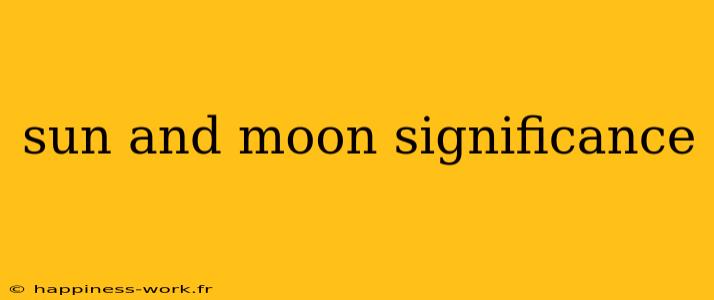The sun and moon are two celestial bodies that have captured human imagination and reverence for centuries. Their significance transcends mere astronomical phenomena; they are imbued with cultural, spiritual, and psychological meanings across various civilizations. This article delves into the multifaceted roles that the sun and moon play in our lives and societies, along with their symbolism, myths, and practical relevance.
Why Are the Sun and Moon Significant?
What Does the Sun Represent?
Answer: The sun typically symbolizes life, energy, and vitality. It is often associated with masculine qualities, strength, and the power of creation.
Analysis: The sun’s role as a life-giver is rooted in its ability to provide warmth and light, essential for the growth of plants and the sustenance of life on Earth. Culturally, many ancient civilizations worshiped the sun as a deity. For example:
- Egyptians: The sun god Ra was considered the most important deity, embodying power, creation, and fertility.
- Aztecs: The sun was revered as Huitzilopochtli, the god of war, representing vigor and courage.
What Does the Moon Represent?
Answer: The moon is often viewed as a symbol of mystery, intuition, and femininity. It is associated with emotions, dreams, and the cycles of life.
Analysis: The moon's phases have a profound effect on various aspects of life, including agriculture, tides, and even human behavior. For example, ancient agricultural societies relied on the lunar calendar to determine the best times for planting and harvesting. Culturally, the moon has inspired myths and legends across many civilizations, such as:
- Greeks: The moon was personified as Selene, a goddess of the night, representing beauty and serenity.
- Native Americans: Different tribes had their own names for each moon cycle, reflecting seasonal changes and their significance in daily life.
Cultural Interpretations of the Sun and Moon
In Astrology
In astrology, the sun and moon hold significant roles in personal and collective interpretations. The sun is associated with one's core identity and ego, while the moon represents emotions and subconscious drives.
Example: In a natal chart, someone with a prominent sun sign may be viewed as confident and assertive, while a strong moon influence could indicate sensitivity and intuition. Understanding these elements can help individuals comprehend their personality traits and relationship dynamics more deeply.
In Religion and Spirituality
How are the sun and moon portrayed in religious texts?
Many religions utilize the sun and moon as symbols to convey spiritual truths:
- Christianity: The sun can be seen as a metaphor for God’s glory, while the moon represents the reflection of divine light in humanity.
- Hinduism: The sun (Surya) and moon (Chandra) are revered as deities, embodying the duality of existence and the cycle of creation and destruction.
Practical Applications of Understanding the Sun and Moon
How Can We Use the Sun and Moon’s Energy in Daily Life?
Understanding the symbolism and significance of the sun and moon can be empowering in practical ways:
- Gardening: Aligning planting and harvesting with lunar cycles can optimize growth and yield.
- Mental Health: Utilizing sunlight for natural energy can improve mood and reduce seasonal affective disorder (SAD). Conversely, moonlight meditation can promote introspection and emotional healing.
How Do the Sun and Moon Affect Our Sleep Patterns?
Answer: Research shows that both natural light from the sun and moon can significantly influence our circadian rhythms and sleep patterns.
Practical Example: Exposure to sunlight during the day helps regulate sleep by enhancing the production of melatonin, while bright moonlight can disrupt sleep patterns. Aiming for a balance—like using blackout curtains during full moons—can help improve sleep quality.
Conclusion
The significance of the sun and moon extends far beyond their physical presence in the sky; they represent deep-rooted cultural meanings, individual identities, and even guide us in our daily practices. Whether viewed through the lens of mythology, spirituality, or practical applications, these celestial bodies continue to inspire and shape human experience.
By recognizing their symbolic importance and integrating their energy into our lives, we can cultivate a deeper connection to the world around us. So the next time you gaze up at the sun or moon, take a moment to appreciate their rich history and the profound roles they play in our existence.
This article incorporates insights and knowledge that draw on cultural understandings and practical applications related to the sun and moon, while encouraging readers to explore their significance on a personal level.
